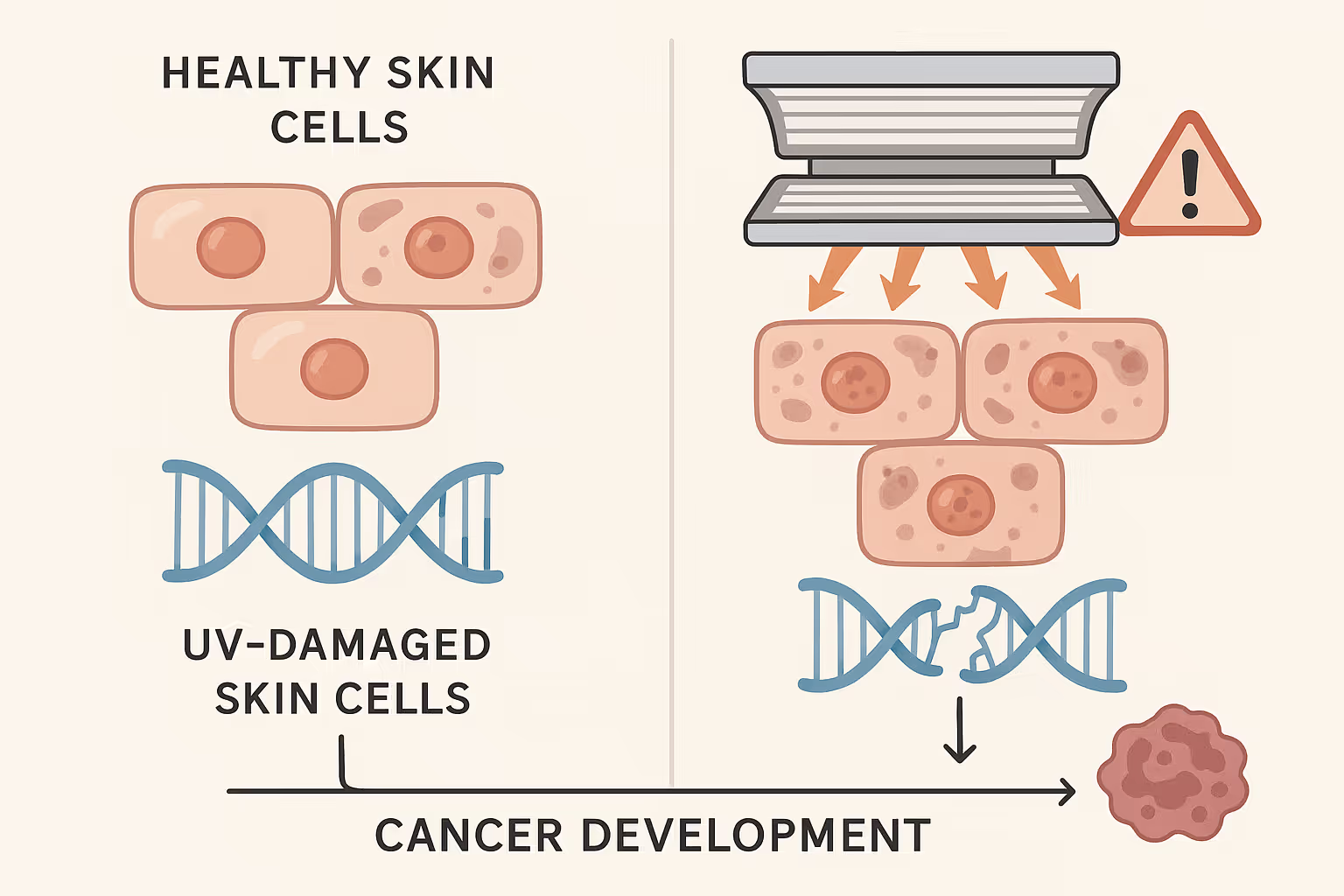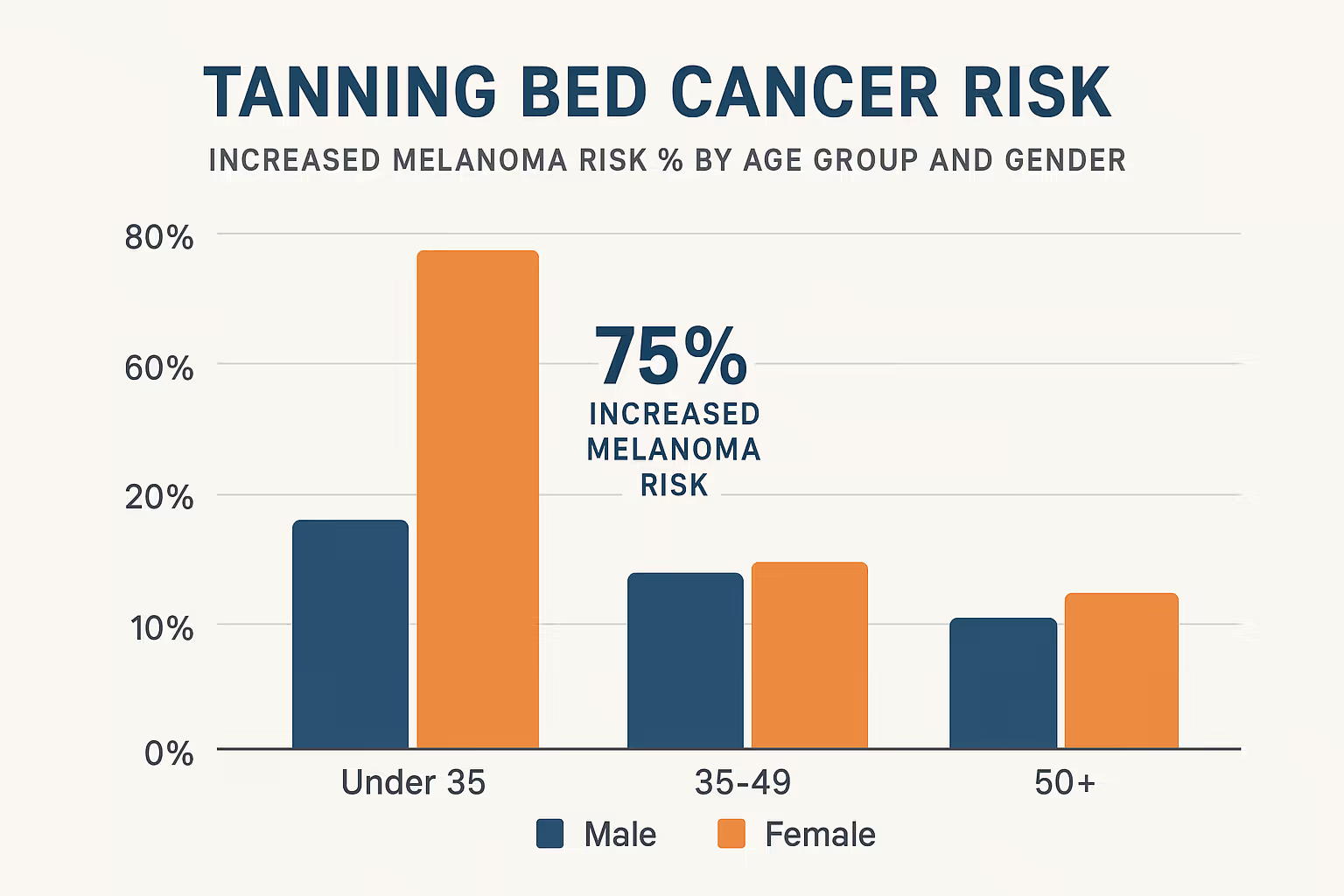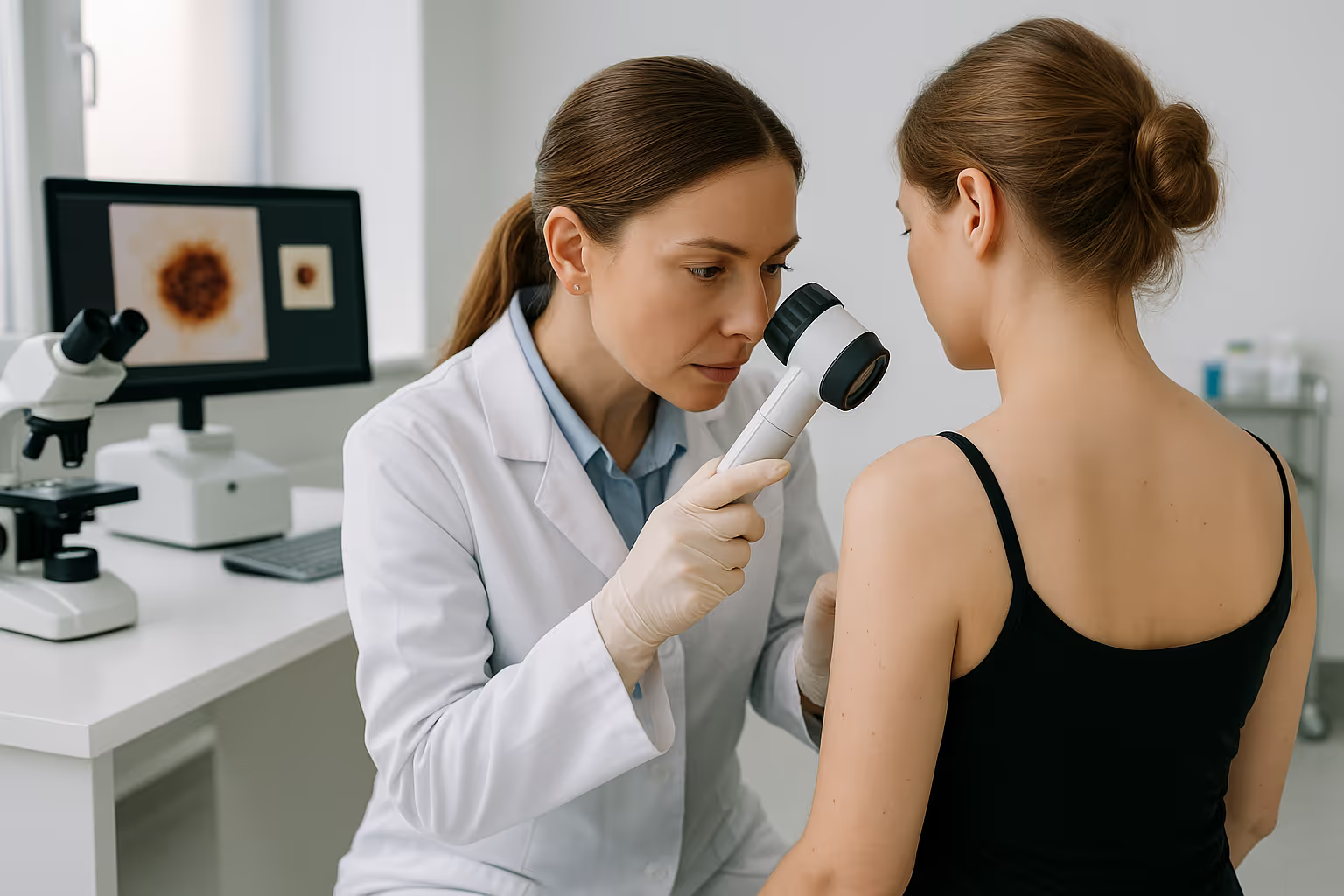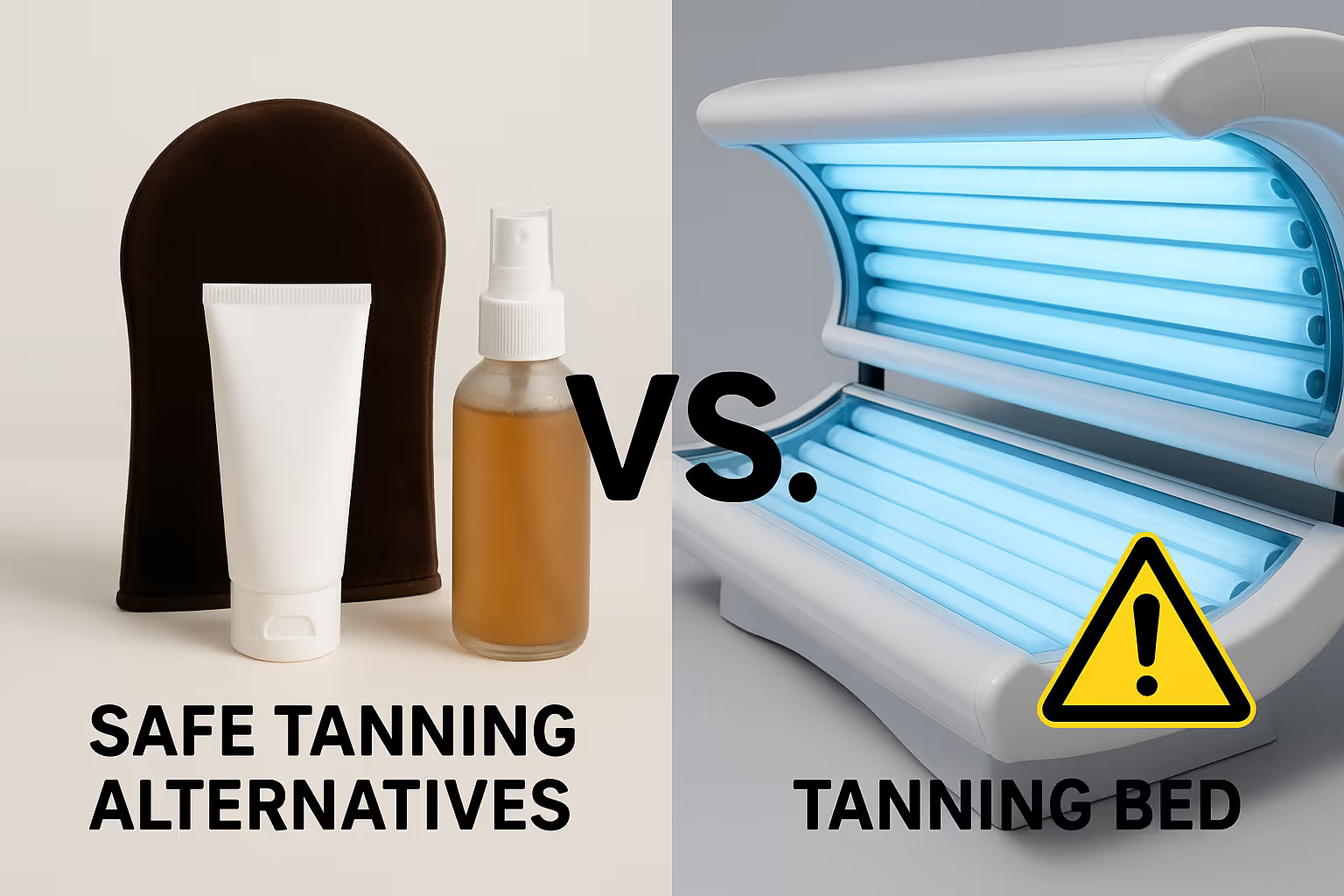Every year, more than 419,000 Americans develop skin cancer directly linked to tanning bed use—a number that exceeds lung cancer cases caused by smoking. This sobering statistic represents just one piece of overwhelming scientific evidence that has led the World Health Organization to classify tanning beds as Class I carcinogens, placing them alongside tobacco and asbestos in terms of cancer-causing potential.
Despite decades of research demonstrating the dangerous relationship between artificial UV exposure and malignant skin changes, millions of people continue to use indoor tanning facilities. The allure of a golden glow often overshadows the stark reality: tanning beds pose a significant and well-documented threat to public health 🚨.
• Tanning beds are classified as Class I carcinogens by the WHO, with the same cancer-causing classification as tobacco and asbestos
• Young women face the highest risk, with those under 30 being six times more likely to develop melanoma if they use tanning beds
• More than 419,000 skin cancer cases annually in the U.S. are directly attributed to indoor tanning, including 6,200 melanomas
• No amount of indoor tanning is safe—skin damage begins with the very first session and compounds over time
• Economic burden reaches $343.1 million annually in treatment costs for tanning-related skin cancers

Indoor tanning equipment emits harmful UVA and UVB radiation at intensities that often exceed those of the midday tropical sun [1]. When this radiation penetrates the skin, it causes immediate and cumulative DNA damage in skin cells, leading to genetic mutations that can progress to cancer over time.
The damaging process begins with the very first tanning session. Each subsequent exposure compounds the genetic damage, creating more mutations and escalating cancer risk. A tan itself represents a negative biological response—the skin's desperate attempt to protect itself from further UV injury.
"The insidious nature of this damage lies partly in its invisibility; symptoms of UV-induced skin damage can take 8 to 10 years to manifest, long after the harmful exposure has occurred."
The statistical evidence reveals alarming risk elevations across different skin cancer types. People who first use a tanning bed before age 35 increase their melanoma risk by 75 percent [2]. The age at which indoor tanning begins matters profoundly:
Individuals who have ever used tanning beds face:
These statistics represent real people facing serious health consequences. Many individuals require surgical intervention to remove cancerous lesions, often resulting in permanent scarring and disfigurement.
The magnitude of skin cancer cases attributable to indoor tanning is staggering. Each year in the United States, more than 419,000 cases of skin cancer are directly linked to tanning bed use, including:
Perhaps most striking is this comparison: more people develop skin cancer from indoor tanning than develop lung cancer from smoking [3].
The health burden extends globally:
These numbers represent a preventable public health crisis that continues to claim lives and burden healthcare systems worldwide.

Women represent a particularly vulnerable demographic in tanning bed usage and subsequent cancer development. The research reveals disturbing patterns:
Statistical Realities for Young Women:
The higher melanoma rates among young females compared to young males may be partially explained by the widespread use of indoor tanning among young women. Research indicates that more than one-fifth of white women aged 18-30 who tan indoors exhibit signs of tanning dependence [4].
The teenage years represent a critical period for cancer risk development:
For parents concerned about their teenagers' tanning habits, consulting with medical professionals can provide valuable guidance on skin cancer prevention and early detection.
Recent research has identified sexual minority males as having a higher lifetime risk of both indoor tanning and subsequent skin cancer compared to heterosexual men, highlighting the importance of targeted public health interventions for this population [5].
The dangers of indoor tanning extend far beyond cancer development. Excessive UV exposure during indoor tanning causes premature skin aging, characterized by:
UV radiation from tanning beds triggers immune suppression, making the body less capable of:
Tanning bed use can cause serious eye damage, including:
Frequent, intentional UV exposure may lead to psychological dependence. Research shows that a significant proportion of regular indoor tanners exhibit addictive behaviors around tanning, including:
The financial burden of indoor tanning-related skin cancers is substantial and growing:
Beyond direct medical expenses, tanning-related skin cancers create additional economic burdens:
For individuals facing skin cancer treatment, understanding cost considerations can help with financial planning and decision-making.
There are some positive signs of progress in reducing indoor tanning usage:
High School Students:
Regulatory Improvements:
Despite progress, concerning patterns persist:

Misconception: Tanning beds provide a safe way to obtain vitamin D.
Reality: Medical experts unanimously reject this rationale. Indoor tanning beds and lamps should be avoided and never used to obtain vitamin D, as the cancer risks far outweigh any potential benefits. Vitamin D can be safely obtained through:
Misconception: Obtaining a "base tan" before sun exposure provides protection.
Reality: This dangerous belief has no scientific foundation. In fact:
Misconception: Darker skin types are immune to tanning damage.
Reality: Tanning damages all skin types, causing DNA injury that can lead to premature aging and skin cancer regardless of baseline pigmentation. While darker skin provides some natural protection, it does not eliminate cancer risk from UV exposure.
The scientific consensus is unequivocal: no amount of UV exposure from tanning beds can be considered safe. The most effective prevention strategy is complete avoidance of indoor tanning facilities.
For those seeking a tanned appearance, safer alternatives include:
Sunless Tanning Options:
Natural Sun Exposure (with Protection):
For individuals with a history of tanning bed use, regular skin cancer screening becomes crucial:
Those requiring skin cancer evaluation or treatment can find qualified professionals through specialized clinics that focus on dermatological procedures.
LetterMeaningWhat to Look ForAAsymmetryOne half doesn't match the otherBBorderIrregular, scalloped, or poorly defined edgesCColorVaried colors within the same moleDDiameterLarger than 6mm (pencil eraser size)EEvolvingChanges in size, shape, color, or texture
When skin cancer develops from tanning bed use, treatment often requires surgical removal that can result in:
Skin cancers caused by tanning bed exposure can be particularly challenging to treat because:
For those facing skin cancer treatment decisions, consulting with experienced medical professionals can provide valuable guidance on treatment options and expected outcomes.

Countries worldwide have implemented various restrictions on indoor tanning:
Complete Bans:
Age Restrictions:
Enhanced Regulations:
Research demonstrates that regulatory interventions can significantly reduce tanning bed usage and subsequent cancer rates. Policy analyses suggest that implementing a complete ban on indoor tanning could save as much as $31.1 billion in North America, while banning only for minors would provide only about one-third of these savings [6].
Current research continues to explore:
Scientists are investigating:
Individuals with a history of indoor tanning should:
Effective prevention requires community-wide efforts:
For comprehensive information about skin health and cancer prevention, individuals can explore additional educational resources and frequently asked questions about skin cancer risks.
The research on tanning beds and skin cancer risk delivers an unambiguous message: indoor tanning represents a serious, preventable health threat that continues to cause significant morbidity, mortality, and economic burden worldwide. With more than 419,000 annual skin cancer cases in the United States directly attributable to tanning bed use, the evidence overwhelmingly supports complete avoidance of these devices.
The classification of tanning beds as Class I carcinogens by the World Health Organization reflects decades of rigorous scientific research demonstrating their cancer-causing potential. Young women face particularly elevated risks, with those under 30 experiencing a six-fold increase in melanoma likelihood when using indoor tanning facilities.
Immediate Action Steps:
The economic burden of treating tanning-related skin cancers—reaching $343.1 million annually—represents just one measure of this preventable public health crisis. More importantly, each statistic represents real individuals facing serious health consequences, often requiring surgical intervention that can result in permanent scarring and disfigurement.
As awareness grows and regulatory measures expand, there are encouraging signs of progress, including a 53% decrease in indoor tanning among high school students between 2009 and 2015. However, continued education and policy efforts remain essential to protect future generations from these preventable cancers.
The choice is clear: the temporary aesthetic appeal of a tan cannot justify the well-documented, serious health risks associated with indoor tanning. By choosing safer alternatives and practicing comprehensive sun protection, individuals can maintain healthy, attractive skin while dramatically reducing their lifetime cancer risk.
[1] American Academy of Dermatology. "Indoor Tanning and Skin Cancer Risk." 2025.
[2] World Health Organization International Agency for Research on Cancer. "Carcinogenicity of Solar and UV Radiation." 2025.
[3] Skin Cancer Foundation. "Indoor Tanning Statistics and Research." 2025.
[4] Journal of the American Medical Association Dermatology. "Tanning Bed Use and Melanoma Risk." 2024.
[5] British Journal of Dermatology. "Sunbed Use and Skin Cancer Mortality." 2024.
[6] Health Economics Research. "Economic Impact of Indoor Tanning Regulations." 2024.